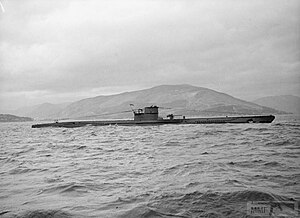German submarine U-927
 U-570 Type VIIC submarine that was captured by the British in 1941. This U-boat is almost identical to U-927.
| |
| History | |
|---|---|
| Name | U-927 |
| Ordered | 25 August 1941 |
| Builder | Neptun Werft AG, Rostock |
| Yard number | 514 |
| Laid down | 1 December 1942 |
| Launched | 3 May 1944 |
| Commissioned | 27 June 1944 |
| Fate | Sunk on 24 February 1945 |
| General characteristics | |
| Class and type | Type VIIC submarine |
| Displacement |
|
| Length |
|
| Beam |
|
| Height | 9.60 m (31 ft 6 in) |
| Draught | 4.74 m (15 ft 7 in) |
| Installed power |
|
| Propulsion |
|
| Speed |
|
| Range |
|
| Test depth |
|
| Complement | 4 officers, 44–52 enlisted |
| Armament |
|
| Service record | |
| Part of: |
|
| Commanders: |
|
| Operations: | 1 patrol |
| Victories: | None |
German submarine U-927 was a Type VIIC U-boat of Nazi Germany's Kriegsmarine during World War II.
She was ordered on 25 August 1941, and was laid down on 1 December 1942 at Neptun Werft AG, Rostock, as yard number 514. She was launched on 3 May 1944 and commissioned under the command of Kapitänleutnant Jürgen Ebert on 27 June 1944.[2]
Design[]
German Type VIIC submarines were preceded by the shorter Type VIIB submarines. U-927 had a displacement of 769 tonnes (757 long tons) when at the surface and 871 tonnes (857 long tons) while submerged.[3] She had a total length of 67.10 m (220 ft 2 in), a pressure hull length of 50.50 m (165 ft 8 in), a beam of 6.20 m (20 ft 4 in), a height of 9.60 m (31 ft 6 in), and a draught of 4.74 m (15 ft 7 in). The submarine was powered by two Germaniawerft F46 four-stroke, six-cylinder supercharged diesel engines producing a total of 2,800 to 3,200 metric horsepower (2,060 to 2,350 kW; 2,760 to 3,160 shp) for use while surfaced, two SSW GU 343/38-8 double-acting electric motors producing a total of 750 metric horsepower (550 kW; 740 shp) for use while submerged. She had two shafts and two 1.23 m (4 ft) propellers. The boat was capable of operating at depths of up to 230 metres (750 ft).[3]
The submarine had a maximum surface speed of 17.7 knots (32.8 km/h; 20.4 mph) and a maximum submerged speed of 7.6 knots (14.1 km/h; 8.7 mph).[3] When submerged, the boat could operate for 80 nautical miles (150 km; 92 mi) at 4 knots (7.4 km/h; 4.6 mph); when surfaced, she could travel 8,500 nautical miles (15,700 km; 9,800 mi) at 10 knots (19 km/h; 12 mph). U-927 was fitted with five 53.3 cm (21 in) torpedo tubes (four fitted at the bow and one at the stern), fourteen torpedoes or 26 TMA mines, one 8.8 cm (3.46 in) SK C/35 naval gun, (220 rounds), one 3.7 cm (1.5 in) Flak M42 and two twin 2 cm (0.79 in) C/30 anti-aircraft guns. The boat had a complement of between 44 — 52 men.[3]
Service history[]
On 24 February 1945, U-927 was sunk by depth charges, south-east of Falmouth in the English Channel, from a British Warwick of 179/K Squadron RAF. Her crew of 47 were all lost.[2]
The wreck is located at 49°54′N 04°45′W / 49.900°N 4.750°WCoordinates: 49°54′N 04°45′W / 49.900°N 4.750°W.[2]
There is some doubt to this claim however. On 8 February 1945, U-927 sent her last radio message from position 59°50′N 05°00′W / 59.833°N 5.000°W while she was en route to her operational area in the English Channel. There have been extensive searches by the UK Hydrographic Office and other parties at the claimed wreck site that have failed to find any evidence of a U-boat.[2]
References[]
Bibliography[]
- Busch, Rainer; Röll, Hans-Joachim (1999). German U-boat commanders of World War II : a biographical dictionary. Translated by Brooks, Geoffrey. London, Annapolis, Md: Greenhill Books, Naval Institute Press. ISBN 1-55750-186-6.
- Busch, Rainer; Röll, Hans-Joachim (1999). Deutsche U-Boot-Verluste von September 1939 bis Mai 1945 [German U-boat losses from September 1939 to May 1945]. Der U-Boot-Krieg (in German). Vol. IV. Hamburg, Berlin, Bonn: Mittler. ISBN 3-8132-0514-2.
- Gröner, Erich; Jung, Dieter; Maass, Martin (1991). U-boats and Mine Warfare Vessels. German Warships 1815–1945. Vol. 2. Translated by Thomas, Keith; Magowan, Rachel. London: Conway Maritime Press. ISBN 0-85177-593-4.
External links[]
- Helgason, Guðmundur. "Patrols by U-927". German U-boats of WWII - uboat.net.
- German Type VIIC submarines
- U-boats commissioned in 1944
- World War II submarines of Germany
- Ships built in Rostock
- 1943 ships
- Maritime incidents in February 1945
- World War II shipwrecks in the English Channel
 WikiMiniAtlas
WikiMiniAtlas